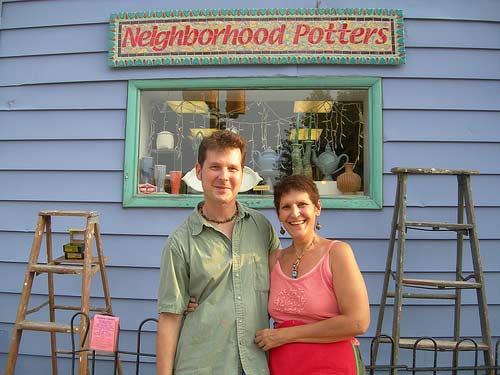Sandi and Neil are art studio potters who have created in the rich cultural environment of the Fairmount neighborhood, surrounding the Philadelphia Museum of Art. They are Neighborhood Potters that make functional pottery because it enriches daily living. Pots help us connect with people on a very basic human level.
What advice would you give a young artist?
First of all, give yourself frequent “reality checks.” Visit working artists studios to see and hear how they sustain themselves. Visit galleries and craft shows to see what other artists are doing, price ranges, booth designs etc. Be realistic in your expectations. Expect it to take some time to get your work out there. Realize that you are responsible for creating an audience for your own work.
Get involved in community activities. Do slide talks and demonstrations even if there is little or no money at first. That will come in time. When I started out I once demonstrated in a storefront window of a craft store on South Street in Philadelphia. I did it for a small trade for something in the shop. Always bring cards to hand out and if possible, pots/work to show and possibly sell. Start applying to gallery shows listed in the various clay magazines. This is a great way to get your work in places outside of your locale, and to build up your resume. Do your homework. Always have good images, statement and resume on hand to send out. Pay attention to deadlines for these things. If you have the type of work that is suitable for craft shows, start applying. If you have shows close to home start there. This is a great way to build up a mailing list for future studio sales. If you are pursuing galleries do it professionally. Create a packet of info on yourself and put it in a nice folder. Follow up with a note or phone call.
Try to find a studio situation with low overhead. Unless you have a strong style and developed body of work that you feel fits into a big sales venue such as a wholesale or retail show, you will probably need some kind of job to sustain you until your work can. Even if you do have the body of work, it never hurts to have some other income you can depend on until your work really takes off. A good part-time situation is ideal if you can find one. The most important thing is to not the job that pays the bills take over your life. Make a studio schedule for yourself and stick to it just as it were your job, and eventually it can be.
Which do you find exerts a stronger influence on your work, success or failure?
Both. You need the successes to help validate what you do and you the failures to keep pushing yourself to overcome them. When you are really working and involved in your work there are always successes and failures, but it is the constant working and the push for discovery that ultimately advances your work.
What was the most difficult for you when you finished school?
Neil: “For me transitioning out of school was unusually easy because I was lucky enough to get a core student position at Penland, although I did miss some formal feedback on my work. I think reading articles like the Studio Potter issue on “Starting Out” is essential. This is now required reading for my students. Trying to find residences can help with the transition out of school.
Sandi: “Since I did not go to college or clay, I had a different kind of transition. I had a full time graphic design business and had been doing clay for fun at night and on weekends at They Clay Studio in Philadelphia, which is where I took my first class in clay. When computers started taking over the graphics business I knew I wanted out. Since I loved clay I decided to see if I could make a living from that. I knew it would take some time so I gave myself 5 years to make the transition. I gave up my own business and kept my hand in graphics as a free-lancer just enough to keep paying the bills. This gave me more time in the studio and allowed me to pursue the work I wanted to make, rather than making what I thought would sell. This was an important factor for me. I started doing the small Christmas sales around my area and that is how I started to see my work. Eventually I started applying to the bigger shows. It actually took the 5 years to make the complete transition. Each of those years I made more money from my clay work and the fifth year I made more from clay than from graphics. That was all the validation I needed and it was then that I gave up the graphics and never looked back.”
The Zoning thing:
When you start a studio you have to make sure that your space is zoned for what you are doing. Check with the city that you live in to see what the zoning requirements are. For us, our building was zoned residential and we were required to have the zoning be commercial for what we wanted to do. In Philadelphia, you have to go to a court hearing and convince the judges that your business is important to your local community. Be prepared. Get letters for neighbors. We brought a portfolio of all our postcards to the hearing and the 5 judges on the panel appreciated and enjoyed that. There was actually a round of applause from others in the courtroom when we were granted our zoning and the judges passed around our portfolio. One of the lawyers there said he had never seen anything like it.
